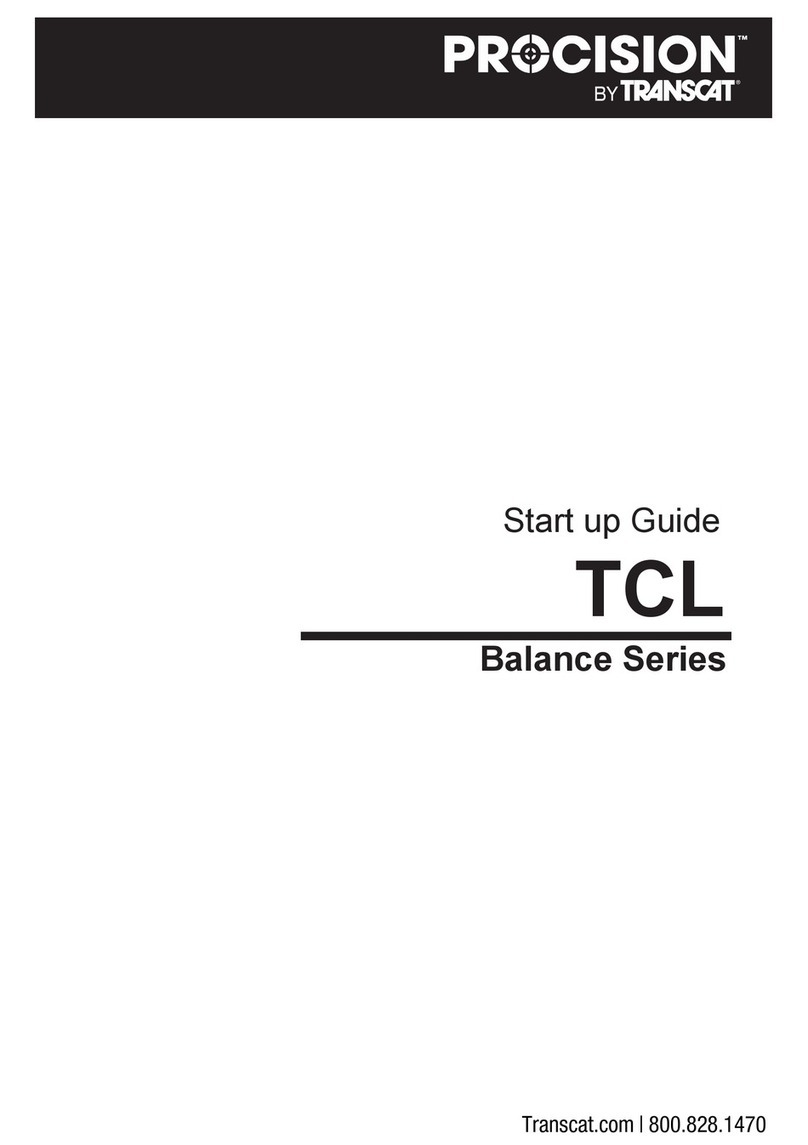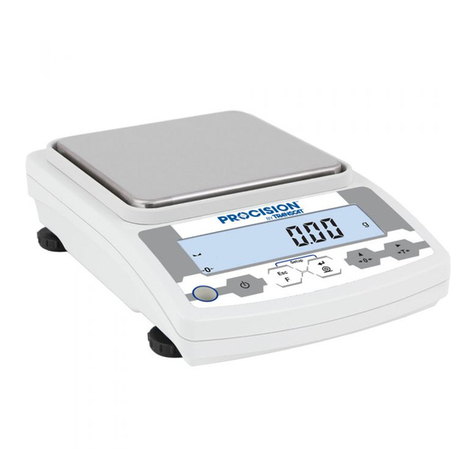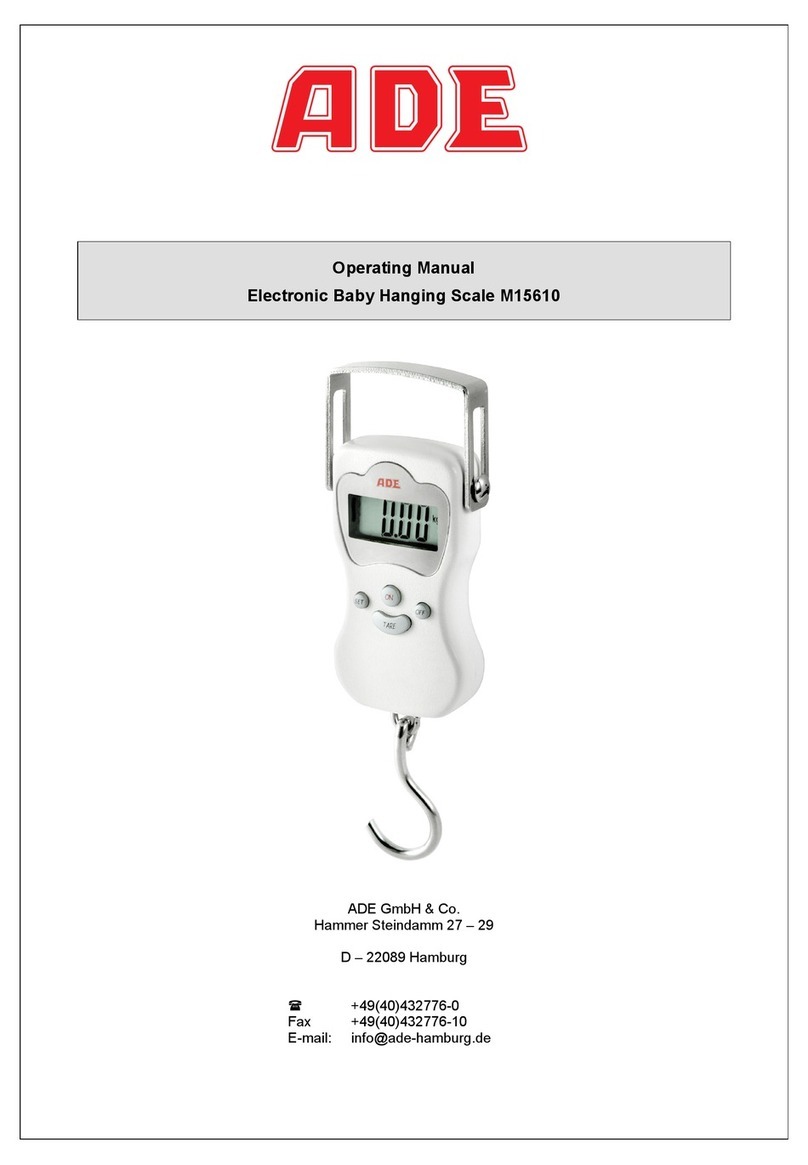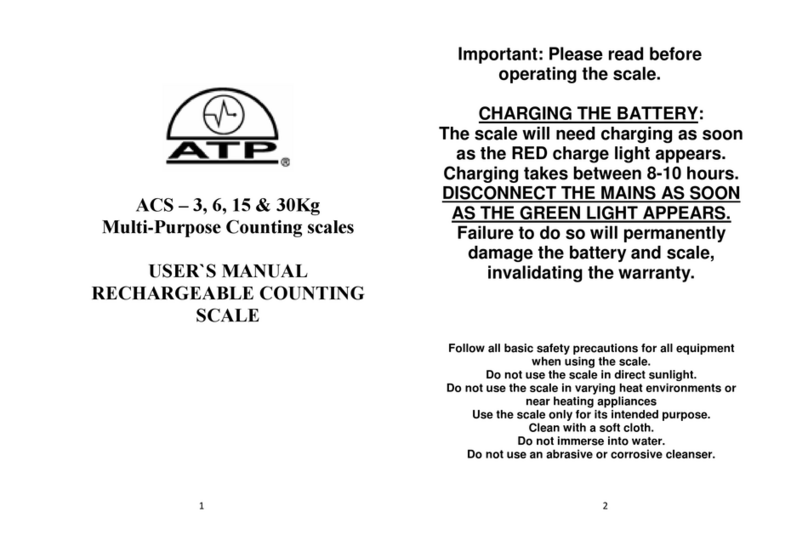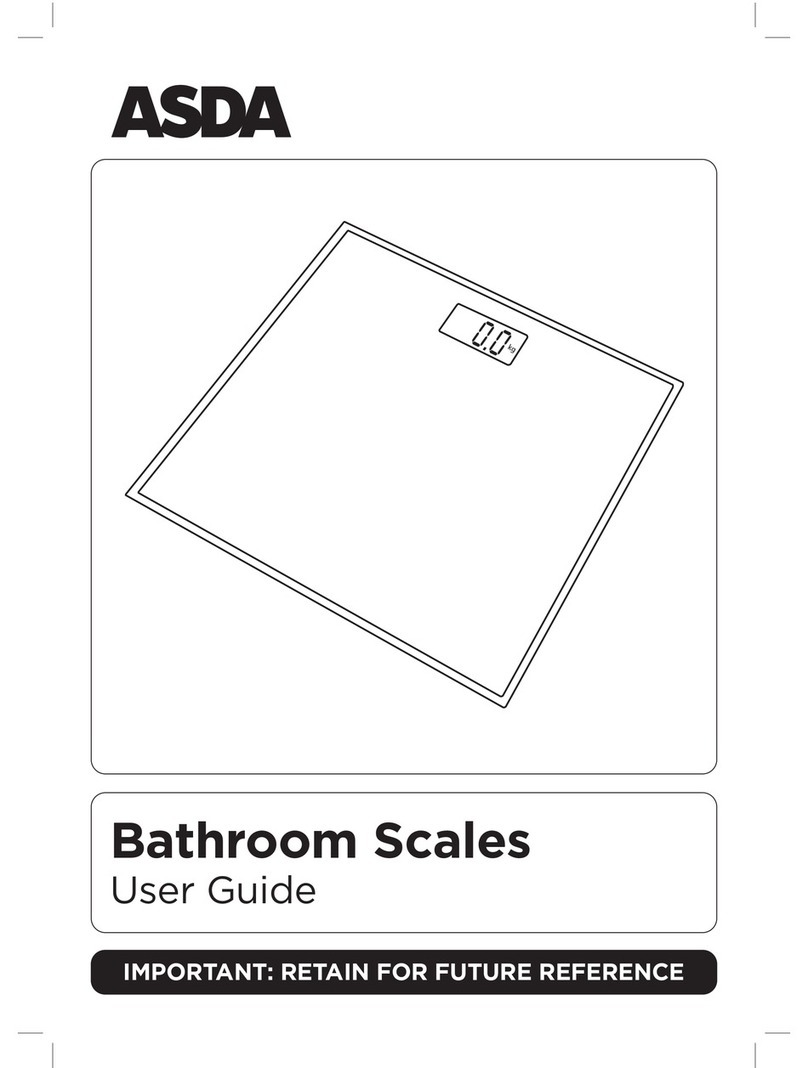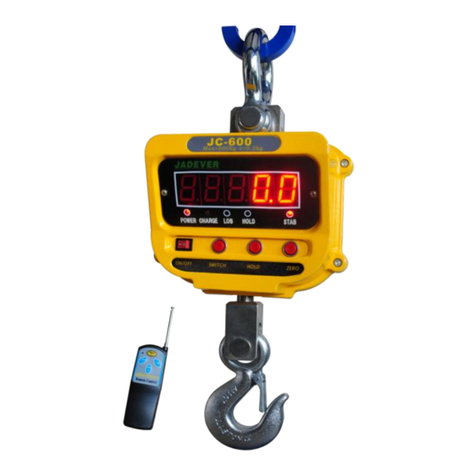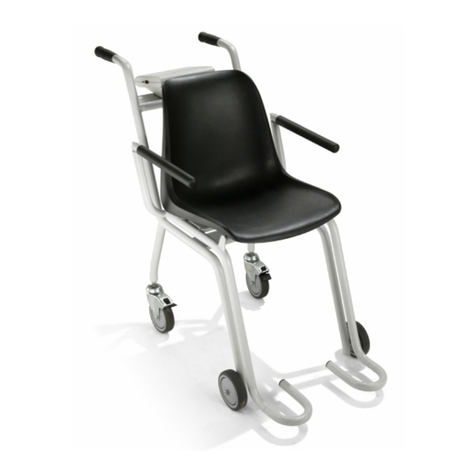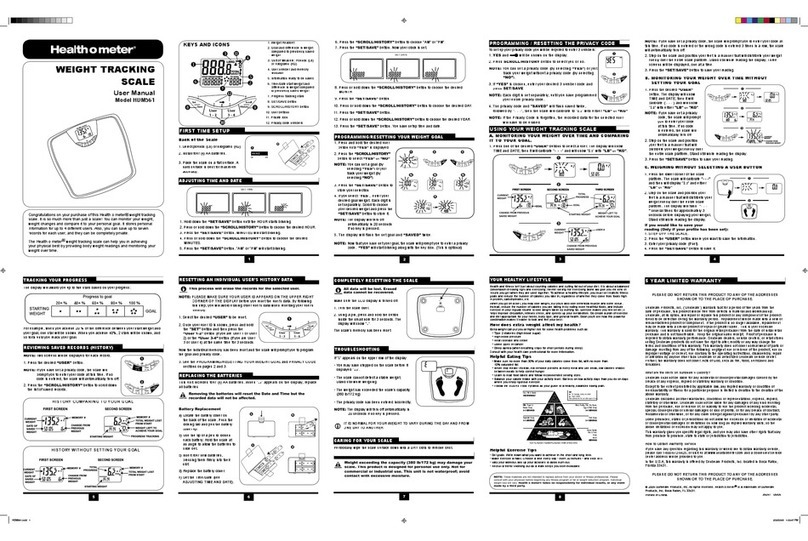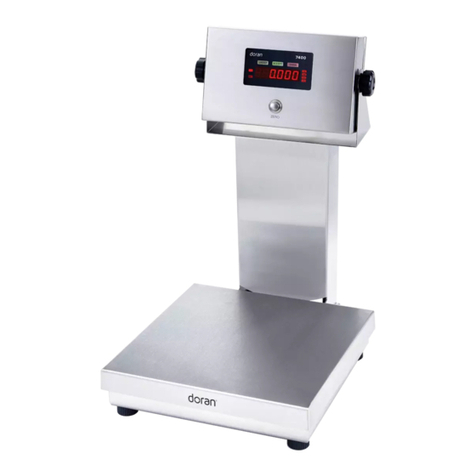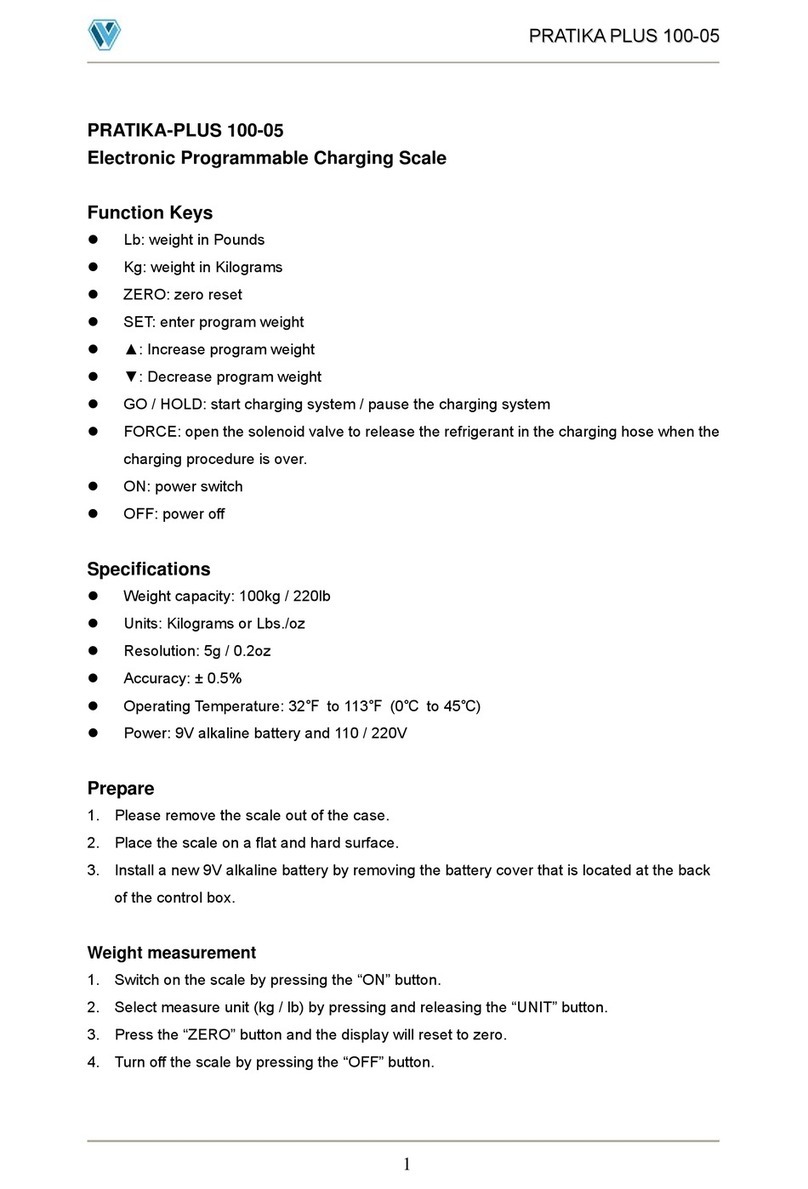Transcat PROCISION TCS Series User manual

User Manual
TCS-SERIES BALANCES
Transcat.com | 800.828.1470

March 2021

1. GENERAL INFORMATION...................................................................................................................................................1
2. PRECAUTIONS....................................................................................................................................................................1
2.1. Maintenance ................................................................................................................................................................... 2
2.1.1 Cleaning ABS Components .................................................................................................................................... 2
2.1.2 Cleaning Stainless Steel Components ................................................................................................................... 2
2.1.3 Cleaning Powder-Coated Components .................................................................................................................. 2
2.2. Battery............................................................................................................................................................................. 2
3. WARRANTYCONDITIONS ...................................................................................................................................................3
4. BALANCEDESIGN ..............................................................................................................................................................3
4.1. Dimensions ..................................................................................................................................................................... 3
4.2. Connection Cables - Diagrams ....................................................................................................................................... 4
4.3. Connectors Description ................................................................................................................................................... 5
5. UNPACKING ANDINSTALLATION .....................................................................................................................................5
6. START-UP............................................................................................................................................................................5
6.1. Leveling ........................................................................................................................................................................... 5
6.2. Powering the Device ....................................................................................................................................................... 6
6.3. Battery Status .................................................................................................................................................................. 6
6.4. Battery Power ................................................................................................................................................................. 6
7. TEMPERATURESTABILIZATION .......................................................................................................................................6
8. KEYPAD AND KEYS............................................................................................................................................................7
9. PROGRAM ...........................................................................................................................................................................8
10.OPERATING BALANCEMENU .........................................................................................................................................10
10.1. Keypad ................................................................................................................................................................ 10
10.2. Return to the Weighing Mode .............................................................................................................................. 10
11.WEIGHING..........................................................................................................................................................................11
11.1. Taring .................................................................................................................................................................. 12
11.2. Manual Tare Entering .......................................................................................................................................... 12
11.3. Zeroing ................................................................................................................................................................ 12
11.4. Units .................................................................................................................................................................... 13
11.5. Start Unit ............................................................................................................................................................. 13
11.6. Temporary Unit .................................................................................................................................................... 13
12.BALANCEPARAMETERS.................................................................................................................................................13
12.1. Filter Level ........................................................................................................................................................... 13
12.2. Value Release ..................................................................................................................................................... 14
12.3. Balance Ambient Conditions ................................................................................................................................ 14
12.4. Autozero .............................................................................................................................................................. 14
12.5. Tare ..................................................................................................................................................................... 15
12.6. Last Digit .............................................................................................................................................................. 15
13.ADJUSTMENT (CALIBRATION)........................................................................................................................................15
13.1. External Adjustment............................................................................................................................................. 16
13.2. User Adjustment .................................................................................................................................................. 16
13.3. Adjustment Report ............................................................................................................................................... 16
14.INTERFACES .....................................................................................................................................................................17
14.1. RS232 Settings .................................................................................................................................................... 17
14.1.1 Baud Rate .......................................................................................................................................................... 17
14.1.2 Parity .................................................................................................................................................................. 17
15.PERIPHERALS...................................................................................................................................................................17
15.1. Computer ............................................................................................................................................................. 17
15.1.1 Computer Port .................................................................................................................................................... 17
15.1.2 Continuous Transmission ................................................................................................................................... 18
15.1.3 Interval For Printouts During Continuous Transmission ..................................................................................... 18
15.2 . Printer ........................................................................................................................................................................ 18
15.2.1 Printer Port ......................................................................................................................................................... 18
16.PRINTOUTS .......................................................................................................................................................................18
16.1. Adjustment Report Printout .................................................................................................................................. 19
16.2. GLP Printout ........................................................................................................................................................ 20
17.MISCELLANEOUS.............................................................................................................................................................20
17.1. Backlight .............................................................................................................................................................. 21
17.2. 'Beep' Sound ....................................................................................................................................................... 21
17.3. Automatic Shutdown............................................................................................................................................ 21
17.4. Date ..................................................................................................................................................................... 22
17.5. Time .................................................................................................................................................................... 22
17.6. Date Format ......................................................................................................................................................... 22
17.7. Time Format ........................................................................................................................................................ 23
17.8. User Menu Default Settings ................................................................................................................................. 23
18.INFORMATION...................................................................................................................................................................23
19.WORKINGMODES.............................................................................................................................................................23
19.1. Running Working Mode ....................................................................................................................................... 23
19.2. Working Modes Settings ...................................................................................................................................... 24
19.3. Weighing ............................................................................................................................................................. 24

19.3.1 Working Mode Accessibility ................................................................................................................................ 24
19.3.2 Save Mode ......................................................................................................................................................... 24
19.3.3 LO Threshold ...................................................................................................................................................... 25
19.4. Parts Counting ..................................................................................................................................................... 25
19.4.1 Working Mode Accessibility ................................................................................................................................ 25
19.4.2 Selecting Working Mode ..................................................................................................................................... 25
19.4.3 Save Mode ......................................................................................................................................................... 25
19.4.4 LO Threshold ...................................................................................................................................................... 25
19.4.5 Setting Reference Mass by Entering Mass of a Single Part ............................................................................... 26
19.4.6 Setting Reference Mass by Determining Mass of a Single Part ......................................................................... 26
19.5. +/- Control............................................................................................................................................................ 27
19.5.1 Working Mode Accessibility ................................................................................................................................ 27
19.5.2 Save Mode ......................................................................................................................................................... 27
19.5.3 LO Threshold ...................................................................................................................................................... 27
19.5.4 Declaring Checkweighing Thresholds ................................................................................................................ 27
19.6. Percent Weighing Against Reference Sample Mass ........................................................................................... 28
19.6.1 Working Mode Accessibility ................................................................................................................................ 28
19.6.2 Selecting Working Mode ..................................................................................................................................... 28
19.6.3 Save Mode ......................................................................................................................................................... 28
19.6.4 LO Threshold ...................................................................................................................................................... 28
19.6.5 Reference Mass Determined by Weighing ......................................................................................................... 29
19.6.6 Reference Mass Determined by Entering ........................................................................................................... 29
19.7. Peak Hold ............................................................................................................................................................ 29
19.7.1 Working Mode Accessibility ................................................................................................................................ 29
19.7.2 LO Threshold ...................................................................................................................................................... 29
19.7.3 Means of Operation ............................................................................................................................................ 30
19.8. Totalizing ............................................................................................................................................................. 30
19.8.1 Working Mode Accessibility ................................................................................................................................ 30
19.8.2 Save Mode ......................................................................................................................................................... 30
19.8.3 LO Threshold ...................................................................................................................................................... 30
19.8.4 Totalizing Procedure ........................................................................................................................................... 30
20.DIAGRAMS OF CONNECTIONCABLES...........................................................................................................................32
21.COMMUNICATIONPROTOCOL ........................................................................................................................................33
21.1. General Information ............................................................................................................................................. 33
21.2. List of Commands ................................................................................................................................................ 33
21.3. Response Format ................................................................................................................................................ 34
21.4. Commands Overview ........................................................................................................................................... 34
21.4.1 Zeroing ............................................................................................................................................................... 34
21.4.2 Taring ................................................................................................................................................................. 34
21.4.3 Give tare value ................................................................................................................................................... 35
21.4.4 Set tare............................................................................................................................................................... 35
21.4.5 Send stable measurement result in basic measuring unit ................................................................................... 35
21.4.6 Immediately send measurement result in basic measuring unit .......................................................................... 36
21.4.7 Send stable measurement result in current measuringunit ................................................................................ 36
21.4.8 Immediately send measurement result in current measuring unit ........................................................................ 37
21.4.9 Switch on continuous transmission in basic measuringunit ................................................................................ 37
21.4.10 Switch off continuous transmission in basic measuring unit ............................................................................. 38
21.4.11 Switch on continuous transmission in current measuring unit .......................................................................... 38
21.4.12 Switch off continuous transmission in current measuringunit ........................................................................... 38
21.4.13 Lock balance keypad ........................................................................................................................................ 38
21.4.14 Unlock balance keypad .................................................................................................................................... 39
21.4.15 Give balance serial number .............................................................................................................................. 39
21.4.16 Send all implemented commands ..................................................................................................................... 39
21.4.17 Manual Printout / Automatic Printout ................................................................................................................. 39
21.4.18 Continuous Transmission ................................................................................................................................. 40
22.TECHNICALSPECIFICATIONS .........................................................................................................................................42
23.TROUBLESHOOTING........................................................................................................................................................43
24.ERRORMESSAGES ..........................................................................................................................................................44

1
1. GENERAL INFORMATION
The TCS-Series precision balance enables fast and accurate mass measurements under
laboratory conditions.
The weighing pan, made of stainless steel and equipped with anti-draft shield, is an integral part of
the TCS-Series balance. Backlit LCD display ensures clear measurement result. The TCS-Series
balance is equipped with an internal battery (comes standard), so it does not have to be connected
to the mains.
The TCS-series balance is equipped with the following interfaces: RS 232, USB type A, USB type B.
The interfaces enable cooperation between the balance and peripheral devices (e.g. printer,
computer, flash drive).
2. PRECAUTIONS
Prior to installation, use or maintenance activities, carefully read this user manual and follow the
provided guidelines.
Prior to the first use, carefully read this user manual. Use the weighing device only as
intended.
Place weighed loads in the center of the weighing pan.
Load the weighing pan with loads of gross weight which does not exceed the maximum
capacity.
Do not leave heavy loads on the weighing pan for longer periods of time.
Protect the indicator against considerable temperature variation, solar and UV radiation,
substances causing chemical reactions.
The TCS scale must not be operated in hazardous areas endangered with explosion of
gases, and in dusty environments.
In case of damage, immediately unplug the device from the mains.
Scales to be decommissioned must be decommissioned in accordance with valid legal
regulations.
Do not let the battery discharge in case of prolonged storage of the device in low
temperature.
A worn out battery can be replaced only by the manufacturer or by the authorized service.
Accumulators do not belong to regular household waste. Symbols on batteries identify
harmful compounds: Pb = lead, Cd = cadmium, Hg = mercury. Dear user, you are
obliged to dispose of the worn out batteries as regulated.

2
2.1. Maintenance
In order to ensure safety in the course of cleaning, it is necessary to disconnect the device from the
mains. With this condition met, uninstall the weighing pan and other detachable components.
Cleaning the weighing pan while still installed may cause
damage of the measuring system.
2.1.1 Cleaning ABS Components
To clean dry surfaces and avoid smudging, use clean non-coloring cloths made of cellulose or
cotton. You can use a solution of water and detergent (soap, dishwashing detergent, glass cleaner).
Gently rub the cleaned surface and let it dry. Repeat cleaning process if needed.
In the case of hard to remove contamination, e.g. residues of adhesive, rubber, resin, polyurethane
foam etc., you can use a special cleaning agents based on a mixture of aliphatic hydrocarbons that
do not dissolve plastics. Before using the cleanser for all surfaces we recommend carrying out tests.
Do not use cleansers containing abrasive substances.
2.1.2 Cleaning Stainless Steel Components
Avoid using cleansers containing any corrosive chemicals, e.g. bleach (including chlorine). Do not
use cleansers containing abrasive substances. Always remove the dirt using microfiber cloth to
avoid damage of protective coating.
In case of a daily maintenance:
1. Remove the dirt using cloth dipped in warm water.
2. For best results, add a little bit of dishwashing detergent.
2.1.3 Cleaning Powder-Coated Components
For preliminary cleaning process stage you need running water or wet sponge featuring large holes,
this will help you to remove loose, heavy dirt. Do not use cleansers containing abrasive substances.
Next, using cloth and cleanser- water solution (soap, dishwashing liquid) gently rub the cleaned
surface.
Avoid using cleanser without water since it may result with damage of the cleaned surface, please
mind that large amount of water mixed with cleanser is a must.
2.2. Battery
The TCS-Series balance is supplied by NiMH-type battery (nickel-metal-hydrogen) of
1800-2800mAh capacity.
In case of prolonged storage of the balance in low temperature, the battery must be
charged.
A worn-out battery can be replaced only by the manufacturer or by the authorized
service.
The equipment including accumulators does not belong to regular household waste.

3
Notice:
Symbols on accumulators identify harmful compounds: Pb = lead, Cd = cadmium, Hg = mercury.
3. WARRANTYCONDITIONS
1. Transcat feels obliged to repair or exchange all elements that appear to be faulty by
production or by construction,
2. Defining defects of unclear origin defects and means of their elimination can only be realized
with assistance of manufacturer and user representatives,
3. Transcat does not bear any responsibility for defects or losses resulting from unauthorized or
inadequate performing of production or service processes,
4. Warranty does not cover:
a. mechanical defects caused by product exploitation other than intended, defects of
thermal and chemical origin, defects caused by lightning, overvoltage in the power
network or other random event,
b. Inappropriate cleaning.
5. Loss of warranty takes place if:
a. a repair is carried out outside Transcat authorized service point,
b. service claims intrusion into mechanical or electronic construction by unauthorized
people,
4. BALANCE DESIGN
4.1. Dimensions
Fig.1. Dimensions of TCS-203 precision balance.

4
Fig.2. Dimensions of TCS-602, TCS-2002 and TCS-3101 precision balances.
4.2. Connection Cables - Diagrams
Fig. 3. Interfaces view
DC IN - power outlet
RS232 - RS 232 connector
USB 2 - USB 'device'connector
USB 1 - USB 'host'connector

5
4.3. Connectors Description
Pin2 – RxD
Pin3 – TxD
Pin5 – GND
RS 232 DB9/M
connector (male)
5. UNPACKING ANDINSTALLATION
1.
Take the device out of the packaging.
2.
Place the balance on a flat and even surface. Keep it far away from any sources of heat.
3.
Install the weighing pan and anti-draft shields in accordance with fig.4.
Fig. 4. Balance installation
6. START-UP
6.1. Leveling
•
Prior first use level the balance. To level the balance, turn its feet and keep turning the feet
until the air bubble takes central position.

6
6.2. Powering the Device
Caution:
Balance can be connected to the mains only with a power adapter that comes standard with the
particular model. Nominal power supply of the power adapter (specified on the power adapter data
plate) has to be compatible to the power from the mains.
Plug the balance to the mains – connect the power adapter to the socket, next connect its connector
to interface located at the back of the balance housing.
Turn the balance on or off using key.
Test of the display unit takes place right after connecting the balance to the power, all the elements
and pictograms are backlit for a short time. Next, the name and the program number appear, the
indication gets to ZERO (displayed reading unit depends on the balance).
If the indication is different than zero, press button.
6.3. Battery Status
An internal battery comes standard with the balance. pictogram, displayed at the top of the display,
signals battery status.
Pictogram operation Overview
No pictogram Battery full. Standard balance operation.
Pictogram displayed continuously Battery status low. The balance will shut down.
Immediately charge the battery.
Pictogram blinks every 1 s. Battery charging. Balance connected to power
supplier, the battery is being charged.
Pictogram blinks every 0.5 s. Battery error. Battery damaged.
6.4. Battery Power
•
Simultaneously
and
keys.
•
Battery power given in % is displayed for 2s.
•
Wait for the home screen to be displayed.
7. TEMPERATURESTABILIZATION
•
For correct operation of the balance the temperature range is +15˚C ± +30˚C;
•
On switching on, the balance requires 30 minutes of temperature stabilization time.
•
During temperature stabilization displayed information may change.
•
Adjustment should be carried out after temperature stabilization.
•
Any changes of temperature and humidity during operation can cause indication errors. Errors
can be corrected by carrying out user adjustment.

7
8. KEYPAD AND KEYS
Fig. 5. TCS-Series keypad
Press to switch the balance on/off
Function button: press to select respective operation mode.
Press to send the weighing result to a printer or a computer.
Press to zero the balance.
Press to tare the balance.
Caution:
On pressing
and
) keys balance menu is displayed and keys' functions change. For
detailed overview of keys' functions go further down this user manual.

8
9. PROGRAM
Main menu is divided into function groups. Function group is a group of interrelated parameters.
Parameter No. Name Options Overview
P1.
CAL
Adjustment
1.1.
CA-E
-
External adjustment
1.2.
CA-U
-
User adjustment with external weight
P2.
rEAd
-
Balance parameters
2.1.
FIL
1, 2, 3
Filter
2.2.
APPr
FASt, PrEc, F_P
Value release
2.3.
Enut
StAb, nStAb
Environment
2.4.
Aut
YES, no
Autozero
2.5.
tare
no, tArF, AtAr, EAcH
Tare
2.6.
ttr
tArEH, tArnn
Tare implementing method
2.7.
LdiG
ALAS, nEur, uuSt
Last digit
P3.
Func
-
Working modes
3.1.
UUGG
-
Weighing
3.1.1.
Acc
YES, no
Working mode On/Off
3.1.2.
Snn
StAb, nStAb, rEPL
Save mode
3.1.3.
Lo
-
LO Threshold
3.2.
PCS
-
Parts counting
3.2.1.
Acc
YES, no
Working mode On/Off
3.2.2.
UUT
S_s, Suu
Working mode
3.2.3.
Snn
StAb, nStAb, rEPL
Save mode
3.2.4.
Lo
-
LO Threshold
3.3.
HiLo
-
+/- control
3.3.1.
Acc
YES, no
Working mode On/Off
3.3.2.
Snn
StAb, nStAb, rEPL
Save mode
3.3.3.
Lo
-
LO Threshold
3.4.
dEu
-
Percent weighing
3.4.1.
Acc
YES, no
Working mode On/Off
3.4.2.
UUT
S_s, Suu
Working mode
3.4.3.
Snn
StAb, nStAb, rEPL
Save mode
3.4.4.
Lo
-
LO Threshold
3.5.
toP
-
Peak hold
3.5.1.
Acc
YES, no
Working mode On/Off
3.5.2.
Lo
-
LO Threshold
3.6.
Add
-
Totalizing
3.6.1.
Acc
YES, no
Working mode On/Off
3.6.2.
Snn
StAb, nStAb, rEPL
Save mode
3.6.3.
Lo
-
LO Threshold
P4.
Conn
-
Interfaces
4.1.
rS
-
RS232 parameters settings
4.1.1.
bAd
2400, 4800, 9600,
19200, 38400, 57600,
115200
RS 232 baud rate
4.1.2. PAr nonE, Odd, EuEn Parity

9
P5.
ducE
-
Peripherals
5.1.
PC
-
Computer
5.1.1.
Prt
nonE, rS232, USbB
Computer port
5.1.2.
Cnt
nonE, CntA, Cntb
Continuous Transmission
5.1.3.
Int
0.1[s] - 1000[s]
Continuous transmission time interval
5.2.
Prtr
-
Printer
5.2.1.
Prt
nonE, rS232, USbb
Printer port
P6.
Prnt
Printouts
6.1.
CrEP
-
Adjustment report
6.1.1.
CtP
YES, no
Adjustment type
6.1.2.
dAt
YES, no
Date
6.1.3.
tin
YES, no
Time
6.1.4.
Idb
YES, no
Balance S/N
6.1.5.
CdF
YES, no
Adjustment difference
6.1.6.
dSh
YES, no
Dashes
6.1.7.
SiG
YES, no
Signature
6.2.
GLP
-
GLP Printout
6.2.1.
dAt
YES, no
Date
6.2.2.
tin
YES, no
Time
6.2.3.
n
YES, no
Net
6.2.4.
t
YES, no
Tare
6.2.5.
b
YES, no
Gross
6.2.6.
CrS
YES, no
Current result
6.2.7.
CrP
YES, no
Adjustment report
P7.
Misc
Miscellaneous
7.1.
bLbt
no, 10, 20, 30, 40, 50,
60, 70, 80, 90, 100
Backlit level in [%]
7.2.
bEEP
YES, no
Key sound
7.3.
t1
nonE, 1, 2, 3, 5, 10
Time-defined finish mode
7.4.
SdAt
-
Date
7.5.
Stnn
-
Time
7.6.
FdAt
1, 2, 3, 4
Date format
7.7.
Ftin
12H, 24H
Time format
7.8.
dFLu
-
User default settings
P8.
InFo
Information on balance
8.1.
Idb
-
Balance serial number
8.2.
PurS
-
Program version
P9.
Unit
-
Units
9.1.
UnSt g, kg, N, ct, lb Start unit
9.2.
Unin g, kg, N, ct, lb
Temporary unit valid until the balance is
turned off.

10
10. OPERATING BALANCEMENU
Use keypad to navigate in menu.
10.1. Keypad
+
Press to enter 'Main Menu'
+
Press to manually enter tare
Press to enter tare from tare values database
Press to edit parameter value and to change it by 1 digit up
Press to move the menu up
+
Press to check battery status
+
Press to preview date/time
Press to move the menu down
Press to change current parameter value
Press to enter particular submenu
Press to select parameter that is to be modified
Press to confirm introduced modifications
Press to leave, parameter remains unmodified
Press to move one menu level up
10.2. Return to the Weighing Mode
Any changes made in balance's memory are automatically saved on return to the main window. To
return to the main window press key.

11
11. WEIGHING
Load the weighing pan. You can read weighing result when , pictogram is displayed. To assure
long-term operation and correct mass measurements follow the rules presented below:
•
Load the weighing pan steadily avoiding shocks:
•
Place weighed loads centrally on the weighing pan (eccentricity errors are specified by PN-EN
45501 standard, points 3.5 and 3.6.2.):
•
Do not load the pan with concentrated force:
•
Avoid side loading, in particular side shocks:

12
11.1. Taring
To determine net mass, put the packaging on the weighing pan. On stabilizing,
press
key
(indication changes to zero, Net pictogram is displayed in the left upper corner):
On loading the weighing pan, net mass is displayed. You can tare repeatedly within the whole
measuring range. While using tare function remember not to exceed the maximum measuring range
of the balance. On unloading the weighing pan, the sum of tared masses with minus sing is displayed.
Caution:
Taring cannot be performed when the displayed value is negative or equal zero. In such case message
Err3 is displayed and short signal isemitted.
11.2. Manual TareEntering
•
Simultaneously press
and
keys.
•
Using and keys set tare value,
•
Press key,
•
Balance returns to weighing mode. Tare value with '-' sign is displayed.
•
Tare can be entered at any moment during the weighing process.
Caution:
Tare cannot be entered manually when tare value is already implemented to balance's memory. In
such case message <Err3> is displayed and a short signal is emitted.
11.3. Zeroing
To zero mass indication press . key. Zero value and following pictograms
and
are displayed. It is possible to zero the balance only when the
indication is stable.
Caution:
Indication can be zeroed only within ±2% range of maximum capacity. If the zeroed value is greater
than ±2% of the maximum capacity, message <Err2> is displayed and short signal is emitted.

13
11.4. Units
<P9.Unit> parameters group enables selecting start and temporary unit. Selecting unit other than [g]
is possible during weighing or during other modes operation. 'Parts counting' and 'Percent weighing'
modes are exceptions for which the unit cannot be changed.
11.5. Start Unit
Setting the start unit.
Procedure:
•
Enter <P9.Unit / 9.1.UnSt> submenu.
•
Press
key to view available units:
Options:
o When [g] is the main unit, then you can select the following units:[g, ct, lb];
•
On selecting start unit, press key to confirm. Next, press key to return to home
screen.
•
The balance turns on with start unit selected.
11.6. Temporary Unit
Temporary unit remains active until the balance is turned off.
Procedure:
•
Enter <P9.Unit / 9.2.Unin> submenu.
•
Press key to view available units:
Options:
o
When [g] is the main unit, then you can select the following units: [g, ct, lb];
•
On selecting start unit, press key to confirm and return to home screen.
12. BALANCE PARAMETERS
You can adjust the balance to ambient conditions (filter level) or to your own needs (autozero, tare
value). The parameters are to be found in <P2.rEAd> submenu.
12.1. Filter Level
•
Enter <P2.rEAd / 2.1.FiL> submenu
•
Press
key to view available filter values: 1 - fast, 2 - average, 3 – slow,
•
Press
key to confirm. Return to home screen.
Caution:
The higher filter level, the longer the indication takes to stabilize.

14
12.2. Value Release
Parameter related with the stabilization rate of measurement result. Depending on the selected
option, weighing time is either shorter or longer.
Procedure:
•
Enter<P2.rEAd / 2.2.APPr> submenu.
•
Press
key to view available options:
F_P - Fast and reliable
PrEc- Reliable
FASt- Fast
•
Press
key to confirm. Return to home screen.
12.3. Balance Ambient Conditions
Parameter relating to ambient and environmental conditions in which the balance operates. If the
ambient conditions are unstable (air drafts, vibrations), select 'unstable' option.
Procedure:
•
Enter <P2.rEAd / 2.3.Enut> submenu.
•
Press
key to view available options: nStAb – unstable, StAb –stable.
•
Press
key to confirm. Return to home screen.
12.4. Autozero
The software features an autozero function (Auto) ensuring precise mass indication. This function
automatically controls and corrects zero indication.
There are, however, some cases when this function can be a disturbing factor for the measuring
process; e.g. very slow placing of a load on the weighing pan (load adding). In such case, it is
recommended to disable the function.
Procedure:
•
Enter <P2.rEAd / 2.4.Aut> submenu.
•
Press
key to view available options: YES – function enabled, no – function disabled.
•
Press
key to confirm. Return to home screen.

15
12.5. Tare
Function enables setting appropriate parameters related with taring.
Procedure:
•
Enter <P2.rEAd / 2.5.tArA> submenu.
•
Press
key to view available options:
no- Basic tare mode. Set (selected) tare value is overwritten on
entering new tare value.
tArF- Last tare value is stored in balance's memory. Tare value is
automatically
displayed on restarting the balance.
AtAr - Tare value is saved after the power supply is disconnected.
EAcH - Automatic taring of each approved measurement.
•
Press
key to confirm. Return to home screen.
12.6. Last Digit
Function enables displaying the last digit of decimal place for a weighing result
-
the measurement is carried out with lesser accuracy.
Procedure:
•
Enter <P2.rEAd / 2.6.LdiG> submenu.
•
Press
key to view available options:
ALAS - All digits visible.
nEur - Last digit is not displayed.
uuSt - Last digit is displayed only for a stable weighing result.
•
Press
key to confirm. Return to home screen.
13. ADJUSTMENT (CALIBRATION)
In order to ensure the highest weighing accuracy, it is recommended to periodically introduce a
corrective factor of indications to balance memory, the said factor must be referred to a reference mass.
It is a balance adjustment.
Adjustment has to be carried out:
•
prior weighing,
•
if long breaks between following measuring series occur,
•
if the ambient temperature has changed dynamically,
•
if the balance's place of use has changed.
Types of adjustment:
•
External adjustment <1.1.CA-E> carried out with external weight of declared mass which
cannot be modified.
•
User adjustment <1.2.CA-u> carried out with any external weight of mass equal or greater than
30% of maximum capacity.

16
13.1. External Adjustment
External adjustment is carried out using external weight of class F1.
Procedure:
•
Enter <P1.CAL / 1.1.CA-E> submenu. Message <UnLoAd> (unload the weighing pan) is
displayed.
•
On unloading the weighing pan, press key.
•
Balance starts determining mass of an empty weighing pan. The process is signaled by
dashes <- >. Next, message <Load> (put weight) is displayed along with mass value to be
put onto weighing pan; e.g.. 200.000g (depending on balance type).
•
Put the weight of a given mass and press key.
•
Balance starts determining mass of a weight. The process is signaled by dashes <- >.
Next, message <UnLoad> (remove weight) is displayed.
•
On unloading the weighing pan, submenu <1.1.CA-E> is displayed.
13.2. User Adjustment
User adjustment is carried out using external weight of class F1.
Procedure:
•
Enter <P1.CAL / 1.2.CA-u> submenu. Message box for entering mass of a weight used for
user adjustment is displayed. Mass of the weight has to be equal or greater than 30% of
maximum capacity.
•
On entering and confirming the weight mass, message <UnLoAd>
(unload the weighing pan) is displayed.
•
On unloading the weighing pan, press key.
•
Balance starts determining mass of an empty weighing pan. The process is signaled by
dashes <- >. Next, message <Load> (put weight) is displayed along with declared mass
value to be put onto weighing pan; e.g.. 100.000g.
•
Put the weight of a given mass and press key.
•
Balance starts determining mass of a weight. The process is signaled by dashes <- >.
Next, message <UnLoad> (remove weight) is displayed.
•
On unloading the weighing pan submenu<1.2.CA-u> is displayed.
13.3. Adjustment Report
Adjustment report is automatically printed on a printer connected to the balance at the end of
each adjustment. Report content is to be declared in
<P6.1.CrEP> menu and described further down this user manual.
Other manuals for PROCISION TCS Series
1
This manual suits for next models
4
Table of contents
Other Transcat Scale manuals
